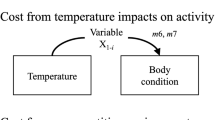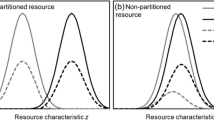Summary
Game-theoretic analyses were completed on the territorial contest behavior of two populations of a desert spider that exhibit markedly different levels of within-species competition. Numerical payoff matrices were constructed from field data collected on the behavior and demography of each population. Payoffs were expressed in terms of expected future egg production. Three behavior patterns that a spider might exhibit following assessment of its weight relative to that of its opponent and the value of the site were considered: withdraw, display, or escalate. The model predicts for the more harsh grassland habitat an evolutionarily stable strategy (ESS) that makes ownership decisive in settling contests between opponents with small weight differences, whereas it otherwise assigns victory to the heavier opponent. Whereas the empirical data collected for this grassland population closely approximates the predicted ESS, that for a population occupying a more favorable riparian habitat deviates significantly. The ESS prediction for this latter population is that an intruding spider will withdraw from a contest if it is similar in weight to the web-owner. Withdrawal is common in this population, but so are display and threat and these actions were not predicted. We hypothesize that gene flow from surrounding habitats is preventing the riparian population from completely adapting to its local environment.
Similar content being viewed by others
References
Brockmann, H. J., Grafen, A. and Dawkins, R. (1979) Evolutionarily stable nesting strategy in a digger wasp.J. Theor. Biol. 77, 473–96.
Charlesworth, B. (1977) Appendix. In Genetic and phenotypic models of natural section (D. G. Lloyd, ed), pp. 550–60.J. Theor. Biol. 69, 543–60.
Grafen, A. (1987) The logic of divisively asymmetric contests: respect for ownership and the desperado effect.Anim. Behav. 35, 462–7.
Hammerstein, P. (1981) The role of asymmetries in animal contests.Anim. Behav. 29, 193–205.
Hammerstein, P. (1985) Spieltheorie und Kampfverhalten von Tieren.Verh. Dtsch. Zool. Ges. 78, 83–99.
Krebs, K. R. and Davies, N. B. (1981)An Introduction to Behavioral Ecology. Sinauer, New York, USA.
Maynard Smith, J. (1983)Evolution and the Theory of Games. Cambridge University Press, Cambridge, UK.
Maynard Smith, J. and Price, G. R. (1973) The logic of animal conflict.Nature 246, 15–18.
Maynard Smith, J. and Riechert, S. E. (1984) A conflicting tendency model of spider agonistic behavior: hybrid-pure population line comparisons.Anim. Behav. 32, 564–78.
Mayr, E. (1963)Animal Species and Evolution. Harvard University Press, Cambridge, USA.
Riechert, S. E. (1976) Web-site selection in a desert spider,Agelenopsis aperta (Gertsch).Oikos 27, 311–15.
Riechert, S. E. (1978a) Energy-based territoriality in populations of the desert spiderAgelenopsis aperta (Gertsch).Symp. Zool. Soc. London 42, 211–22.
Riechert, S. E. (1978b) Games spiders play. I. Behavioral variability in territorial disputes.Behav. Ecol. Sociobiol. 3, 135–62.
Riechert, S. E. (1979) Games spiders play. II. Resource assessment strategies.Behav. Ecol. Sociobiol. 4, 1–8.
Riechert, S. E. (1981) The consequences of being territorial: spiders, a case study.Amer. Natur. 117, 871–2.
Riechert, S. E. (1982) Spider interaction strategies: communication versus coercion. InSpider Communication: Mechanisms and Ecological Significance (P. N. Witt and J. Rovner, eds). Princeton University Press, Princeton, USA.
Riechert, S. E. (1984) Games spiders play. III. Cues underlying context associated changes in agonistic behavior.Anim. Behav. 32, 1–15.
Riechert, S. E. (1985) Decision problems in multiple goal contexts: spider habitat selection.Zeitschrift fur Tierpsychol. 70, 53–69.
Riechert, S. E. (1986) Spider fights: a test of evolutionary game theory.Amer. Sci. 4, 604–10.
Riechert, S. E. (1987) Between population variation in spider territorial behavior: Hybrid-pure population line comparisons. InArthropod Behavioral Genetics (M. Huettel, ed.). Plenum Press, New York, USA (in press).
Riechert, S. E. Energetic costs of fighting.Amer. Zool. (in press b).
Riechert, S. E. and Hammerstein, P. (1983) Game theory in an ecological context.Ann. Rev. Ecol. Syst. 14, 377–409.
Riechert, S. E. and Tracy, C. R. (1975) Thermal balance and prey availability: bases for a model relating web-site characteristics to spider reproductive success.Ecology 56, 265–84.
Wahlert, T. G. von (1965) The role of ecological factors in the origin of higher levels of organization.Syst. Zool. 14, 288–300.
Author information
Authors and Affiliations
Rights and permissions
About this article
Cite this article
Hammerstein, P., Riechert, S.E. Payoffs and strategies in territorial contests: ESS analyses of two ecotypes of the spiderAgelenopsis aperta . Evol Ecol 2, 115–138 (1988). https://doi.org/10.1007/BF02067272
Issue Date:
DOI: https://doi.org/10.1007/BF02067272




